
Power generation products company Generac (NYSE: GNRC) fell short of the markets revenue expectations in Q3 CY2025, with sales falling 5% year on year to $1.11 billion. Its non-GAAP profit of $1.83 per share was 16.7% below analysts’ consensus estimates.
Is now the time to buy Generac? Find out by accessing our full research report, it’s free for active Edge members.
Generac (GNRC) Q3 CY2025 Highlights:
- Revenue: $1.11 billion vs analyst estimates of $1.19 billion (5% year-on-year decline, 6.6% miss)
- Adjusted EPS: $1.83 vs analyst expectations of $2.20 (16.7% miss)
- Adjusted EBITDA: $192.6 million vs analyst estimates of $233.1 million (17.3% margin, 17.4% miss)
- Operating Margin: 9.3%, down from 14.4% in the same quarter last year
- Free Cash Flow Margin: 8.7%, down from 15.6% in the same quarter last year
- Market Capitalization: $11.16 billion
“Home standby and portable generator shipments grew sequentially in the quarter but were below expectations as a result of a power outage environment that was significantly below baseline average and the lowest third quarter of total outage hours since 2015,” said Aaron Jagdfeld, President and Chief Executive Officer.
Company Overview
With its name deriving from a combination of “generating” and “AC”, Generac (NYSE: GNRC) offers generators and other power products for residential, industrial, and commercial use.
Revenue Growth
A company’s long-term sales performance is one signal of its overall quality. Even a bad business can shine for one or two quarters, but a top-tier one grows for years. Thankfully, Generac’s 13.5% annualized revenue growth over the last five years was excellent. Its growth beat the average industrials company and shows its offerings resonate with customers.
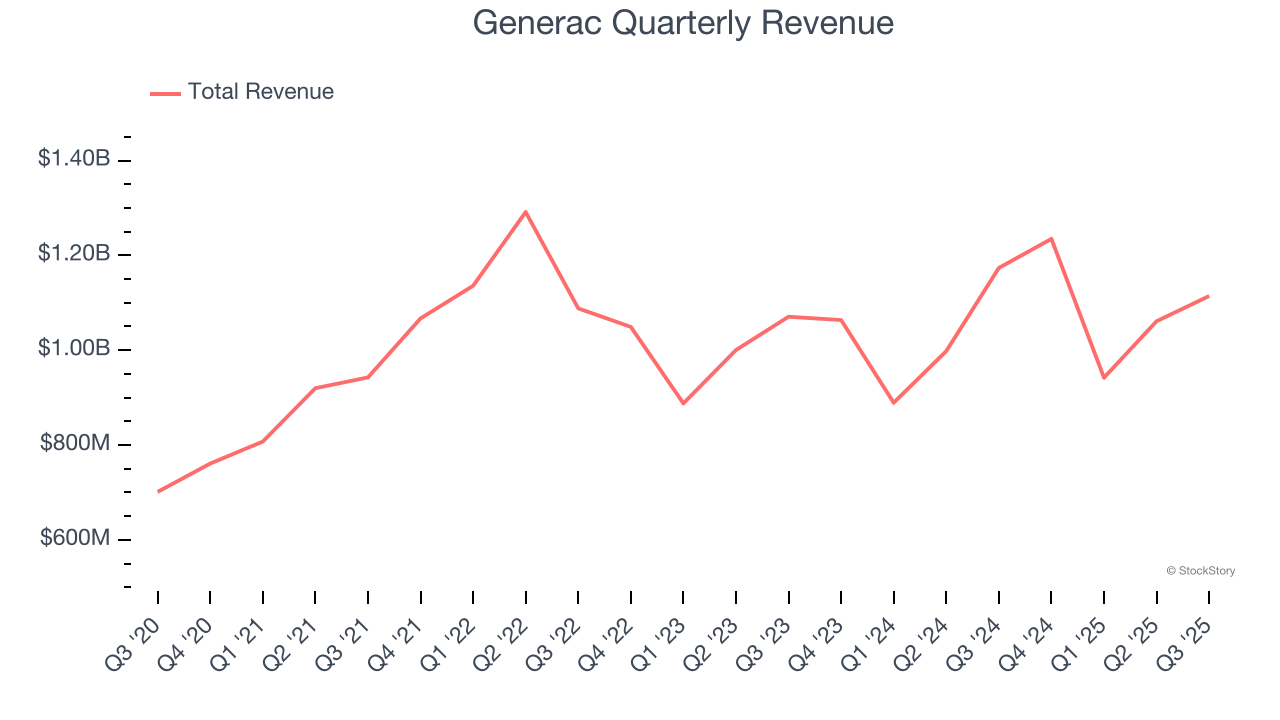
We at StockStory place the most emphasis on long-term growth, but within industrials, a half-decade historical view may miss cycles, industry trends, or a company capitalizing on catalysts such as a new contract win or a successful product line. Generac’s recent performance shows its demand has slowed significantly as its annualized revenue growth of 4.2% over the last two years was well below its five-year trend. We also note many other Renewable Energy businesses have faced declining sales because of cyclical headwinds. While Generac grew slower than we’d like, it did do better than its peers. 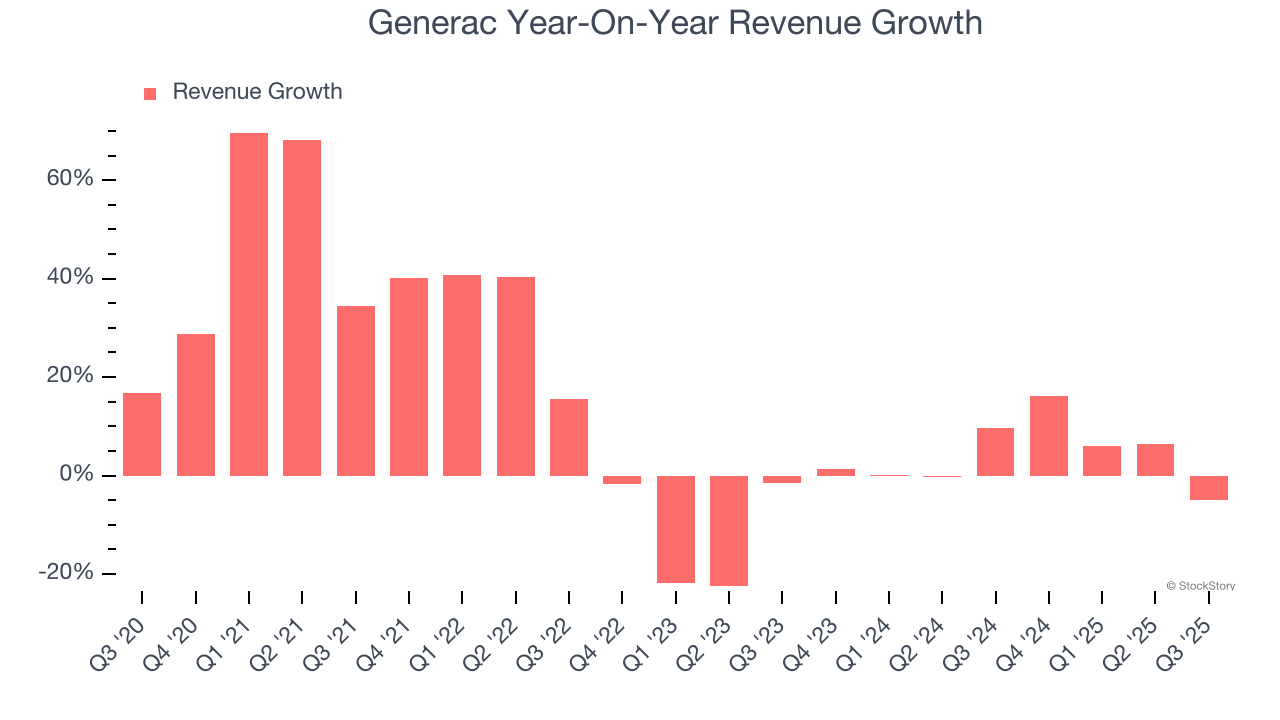
We can dig further into the company’s revenue dynamics by analyzing its most important segments, Residential and Commercial and Industrial, which are 56.3% and 32.1% of revenue. Over the last two years, Generac’s Residential revenue (sales to consumers) averaged 9.5% year-on-year growth. On the other hand, its Commercial and Industrial revenue (sales to contractors and pros) averaged 2.2% declines. 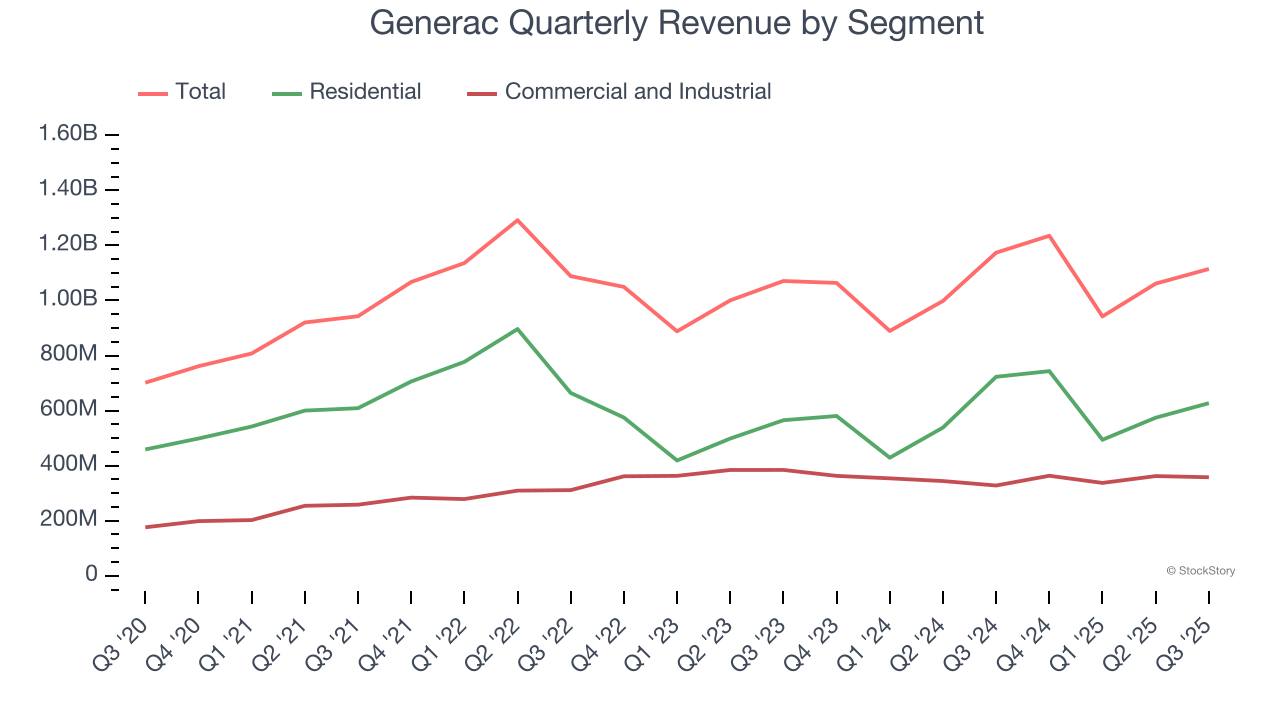
This quarter, Generac missed Wall Street’s estimates and reported a rather uninspiring 5% year-on-year revenue decline, generating $1.11 billion of revenue.
Looking ahead, sell-side analysts expect revenue to grow 7.7% over the next 12 months, an improvement versus the last two years. This projection is above the sector average and indicates its newer products and services will catalyze better top-line performance.
Software is eating the world and there is virtually no industry left that has been untouched by it. That drives increasing demand for tools helping software developers do their jobs, whether it be monitoring critical cloud infrastructure, integrating audio and video functionality, or ensuring smooth content streaming. Click here to access a free report on our 3 favorite stocks to play this generational megatrend.
Operating Margin
Generac has been an efficient company over the last five years. It was one of the more profitable businesses in the industrials sector, boasting an average operating margin of 13.1%. This result isn’t surprising as its high gross margin gives it a favorable starting point.
Looking at the trend in its profitability, Generac’s operating margin decreased by 9.5 percentage points over the last five years. This raises questions about the company’s expense base because its revenue growth should have given it leverage on its fixed costs, resulting in better economies of scale and profitability.
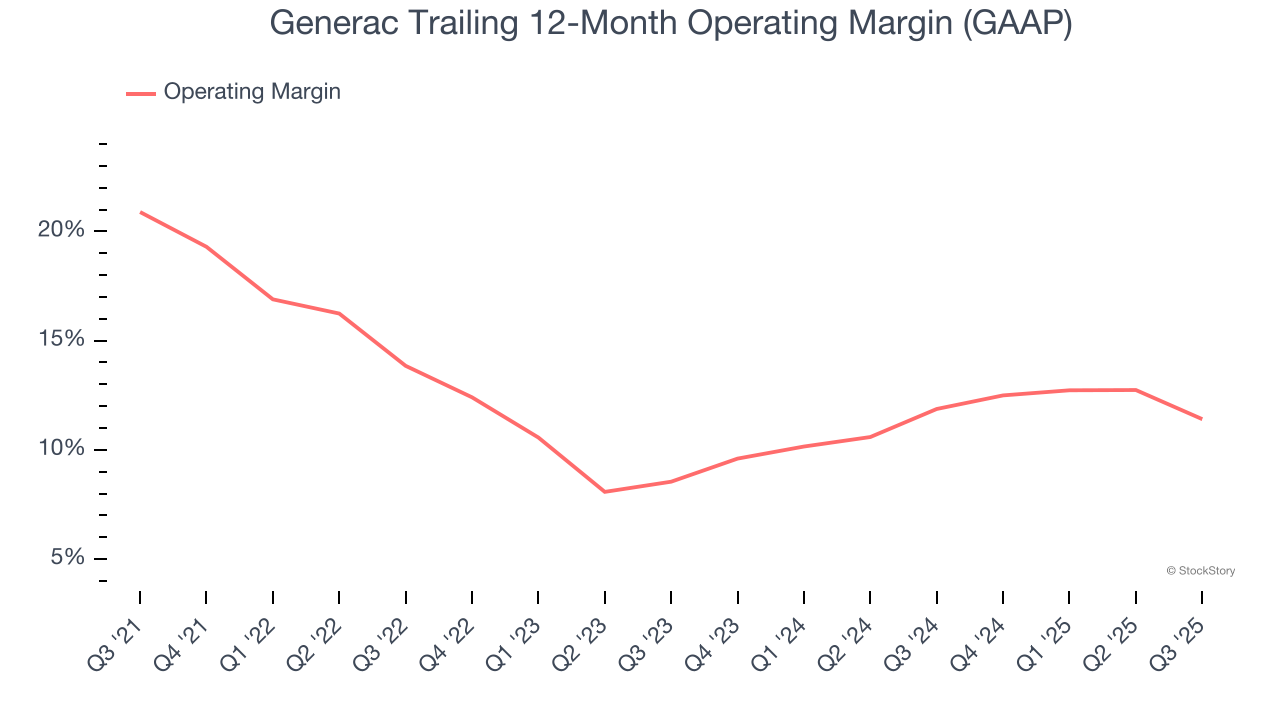
This quarter, Generac generated an operating margin profit margin of 9.3%, down 5.1 percentage points year on year. Since Generac’s operating margin decreased more than its gross margin, we can assume it was less efficient because expenses such as marketing, R&D, and administrative overhead increased.
Earnings Per Share
Revenue trends explain a company’s historical growth, but the long-term change in earnings per share (EPS) points to the profitability of that growth – for example, a company could inflate its sales through excessive spending on advertising and promotions.
Generac’s EPS grew at an unimpressive 5.1% compounded annual growth rate over the last five years, lower than its 13.5% annualized revenue growth. This tells us the company became less profitable on a per-share basis as it expanded due to non-fundamental factors such as interest expenses and taxes.
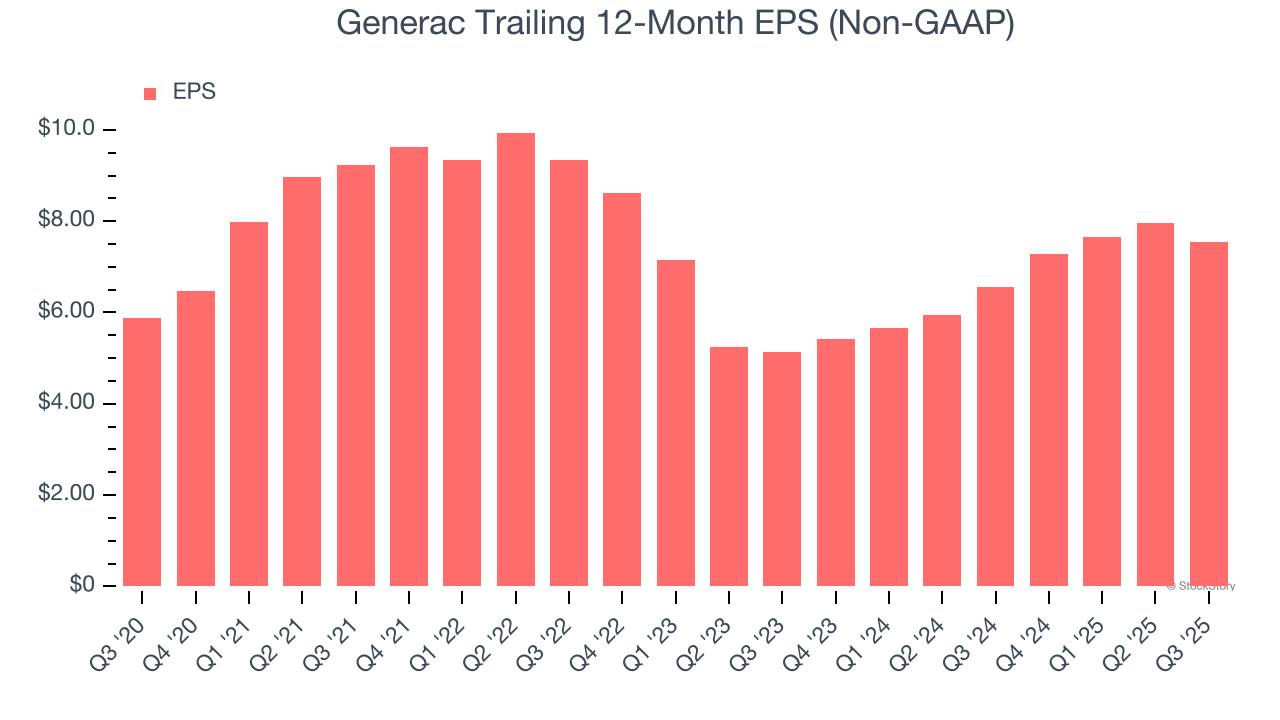
We can take a deeper look into Generac’s earnings to better understand the drivers of its performance. As we mentioned earlier, Generac’s operating margin declined by 9.5 percentage points over the last five years. This was the most relevant factor (aside from the revenue impact) behind its lower earnings; interest expenses and taxes can also affect EPS but don’t tell us as much about a company’s fundamentals.
Like with revenue, we analyze EPS over a more recent period because it can provide insight into an emerging theme or development for the business.
For Generac, its two-year annual EPS growth of 21.2% was higher than its five-year trend. This acceleration made it one of the faster-growing industrials companies in recent history.
In Q3, Generac reported adjusted EPS of $1.83, down from $2.25 in the same quarter last year. This print missed analysts’ estimates. Over the next 12 months, Wall Street expects Generac’s full-year EPS of $7.54 to grow 15.8%.
Key Takeaways from Generac’s Q3 Results
Generac missed across the board, with revenue, EBITDA, and EPS all missing. Overall, this was a bad quarter. The stock traded down 15.3% to $161 immediately following the results.
Generac’s earnings report left more to be desired. Let’s look forward to see if this quarter has created an opportunity to buy the stock. What happened in the latest quarter matters, but not as much as longer-term business quality and valuation, when deciding whether to invest in this stock. We cover that in our actionable full research report which you can read here, it’s free for active Edge members.


















